They will not only slow down the achievement of results, but can also cost you health.
Strength training is really effective when it comes to pumping muscles. However, not everything is so simple. To achieve results, you need not only to work hard and for a long time, but also to monitor the technique of execution. After all, its violation can lead to unpleasant consequences.

Boris Ilyin
World Class Fitness Trainer
Today I will tell you about the mistakes that should be avoided during strength training in order to achieve results and not get injured.
No warm-up
The less time you spend on warming up, the more you will then spend on treatment and recovery. Each organism has its own safety margin, the lack of warm-up in the medium term leads to chronic injuries.
Before starting strength training, it is necessary to prepare the central nervous system, warm up the body and let it know that there will be physical activity now.
It is necessary to raise the heart rate for cardio for 7-15 minutes, prepare the articular ligamentous apparatus and muscles for the load by pre-stretching the main muscle groups involved in the work for 5-7 seconds. And also perform a smooth lifting of the weight of shells and weights before reaching the working weights.
Working in a shortened amplitude with an uncontrolled tempo
Working in a shortened incomplete amplitude, you deprive yourself of a full-fledged effect, the benefits of the load fall. Working at a fast, uncontrolled pace – similarly. The total time spent by the muscle under load is important, not the number of repetitions, because it is conditional and invented for the convenience of the trainees.
Perform the exercise in full amplitude, in which the muscles and joints should work, taking into account your anatomical features and contraindications. Do not neglect the negative phase of the exercise. During this phase, the effect of the load is higher than with a positive one.
For example, when lifting a barbell on the biceps, many people hardly lift it up and then throw it down very quickly. You can't do that. It is necessary to perform the reverse movement just as slowly.

Hyperextension with a round back
This is an exercise where the muscles of the back of the thigh and buttocks do the main work, and the back works in an isometric / static mode. By rounding your back and bending your spine, you provoke a very heavy load in the lower back, which can lead to protrusions and hernias in the future.
The exercise is performed with a straight back, with a natural lumbar lordosis, while the shoulder blades are given. A smooth tilt is carried out at the expense of the hip joint, and extension to a neutral position occurs due to the tension of the buttocks and the muscles of the posterior surface of the thigh.
Withdrawal with dumbbells with shoulder rotation inwards
Such a variation of performance can lead to fatigue injury – impeachment-shoulder joint syndrome. In this technique, the humerus comes into contact with the shoulder blade, rubbing the tendon of the supraspinatus muscle.
The correct technique of execution will be to perform a retraction with a slight rotation, 10-15 degrees, of the humerus outward, so that the elbow processes at the end point of movement are directed diagonally downward. Also, at the end point, the shoulder joint is higher than the elbow, and the elbow joint is higher than the wrist joint, a kind of descending straight line.
Traction of the upper block by the head
The pull of the block behind the head can also lead to impeachment syndrome, the reasons are the same. When working in this range, the humerus will have to rotate inward, and the lower you pull, the more pronounced it will be.
Do not perform a head pull, do it to the chest, at the end point your shoulder bones should be located in the plane of the chest, elbows should strive to press against the body, shoulder blades are brought and lowered.

Squat with a vertical body or a strong tilt
In the case of vertical execution, there will be a breaking load on the lower back and, most likely, a very strong withdrawal of the knees forward and weight transfer to the socks to keep balance.
In the case of a strong tilt of the body, the load on the legs will be minimal, everything will go to the extensors of the spine, and the peak load will be on the lumbar region.
Squats are a multi–joint exercise with simultaneous movement of the pelvis backwards and rotation of the hip outward. The knees should be aligned with the middle toes of the feet. There should be a balance between the slope of the body and the depth of the squat, so that the center of mass of the body coincides with the center of mass of the legs. The centers should be centered between your feet to ensure a stable position.
Build your training process correctly, paying attention to the technique of performing each exercise. After all, training should primarily benefit, not harm your body.
Source: championat
Follow us on в Telegram


















